Reviews
Review: The Legend of Zelda: Ocarina of Time 3D
August 16, 2011, Author: Andy Corrigan
Over the course of November 1998, one of the most important games of all time was released. Not just important for Nintendo, gamers worldwide or the industry (although it was important for all those things and more), but mainly for me personally… which is all that matters, really isn’t it? My well-being?!
It wasn’t so much just a good game as it was an industry milestone. Universally loved, beautifully crafted, full of charm and a joy to play; it’s still the game that many people (including those actively involved in games development) will point to as the pinnacle of game design. It was, and still is, one of those games that is truly timeless; a rare commodity in a day and age where ‘ground-breaking’ titles are forgotten as just quickly as they are hyped.
For me? If I tell you that it was the first game that enraptured me so much that I feigned illness from school for an entire week just to play it (sorry mum!), and one that for well over a decade I would play annually, it should probably tell you all you need to know about my feelings for this particular title. With the seminal game recently remastered and given the 3D treatment for Nintendo’s latest handheld, I was more than happy to delve back in and see if Ocarina of Time was still worthy of such lofty acclaim today.
A timeless story
In Ocarina of Time, you find our hero as a member of the tree-dwelling community of the Kokiri forest. The inhabitants of this forest all worship a guardian, the Great Deku Tree, who assigns a fairy to all who live there. There is one without a fairy, however, and that (somewhat predictably) is Link. Treated as an outsider and clearly different to all the others, he just doesn’t seem to belong. He shouldn’t worry; his life is about to get a lot more interesting…
After being awoken by a nightmare in which he witnesses a princess and her bodyguard being pursued by a mysterious man in black, Link is summoned to the Deku Tree by Navi, a fairy who has been newly assigned to guide him. Upon greeting the huge talking tree, Link is informed that the land of Hyrule is in peril and that he will be embarking on a journey to Hyrule castle, tasked with saving the Princess and Hyrule in the process.
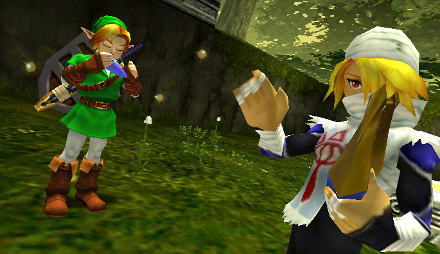
Let's jam!
Yes, this is clearly a Legend of Zelda game. An older one too, so the age-old theme of Ganon/Ganondorf attempting to kidnap the Princess Zelda for sinister purposes is present and correct. There is, however, a rich, charming and sometimes dark storyline bubbling underneath. This is not only told with words, but also in the environments, and the trials and tribulations of the cast of colourful characters that you’ll encounter along the way. Ocarina of Time is one of those rare games that says a lot more in few words than most games manage with full dialogue, and as such it’s easy to lose yourself in the lore of the Legend of Zelda.
Allowing yourself to embrace the story is helped massively by basic-but-excellent characterisation. Even Link, practically mute throughout, is instantly relatable thanks to his humble beginnings and outsider status. Despite this, rather than becoming disaffected, he instead possesses an unbreakable spirit. It’s the underdog effect, and the reason why I personally think many stick on this particular iteration of Link as their favourite in the franchise.
Heeeeey ocarina!
If you played the original on the N64 (or later on Gamecube thanks to the special editions of Wind Waker), you’ll be pleased to know that from a gameplay perspective, the game is mostly untouched. For those who haven’t played it before, you’re in for a real treat.
The game is a traditional Zelda title in every sense. You have a world map, which you’ll be traversing to reach dungeons to not only rid the area of the evil that dwells within, but also to acquire a weapon that will enable you to reach subsequent areas. You’re not constantly handheld either (excuse the pun). Although the game may use the annoyance of Navi (Hey! Listen!) to point you in the right direction, getting there and working it out is entirely up to you.
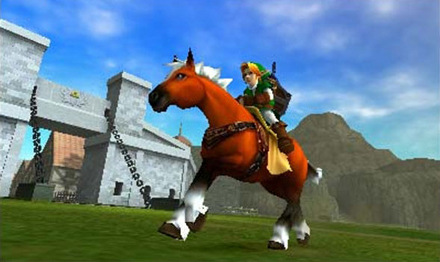
Epona to the rescue!
It’s probably easier to think of Ocarina of Time as a series of puzzles. When you reach a dungeon, you’ll find that you can’t access everything right away. That is, until you explore and find the power-up or weapon therein, that will enable you to work your way towards the boss. There are so many weapons and tools in the Zelda games that it’d be impossible to list and describe them all, even in one of our reviews, but rest assured that old favourites like the hookshot, Master Sword, and other powered accessories are all available.
The bosses, as always, are puzzles in their own right, with clear patterns that you must work out if you’re to stand a chance of progressing. Once you do that, they tend to be extremely easy, but it’s not always clear from the outset. Outside of the dungeons, you’re presented with this big, beautiful world to explore at your leisure, and I point-blank refuse to spoil any of this wonder for anyone. Rest assured, there’s lots to see and do.
It’s not all precisely the same, though, as this port has made good use of some of the 3DS’s best features to further improve the experience. Easily the best addition, in my opinion, is using the touch screen to manage inventory, gear and maps. Previously, the game could be a bit fiddly in this respect when just using the analogue stick, thanks to the amount of times you’ll need to reshuffle your equipped items. This is not a criticism, either, but simply due to the sheer variety the game has to offer at every turn. Now, you can easily assign your items at a moment’s notice, and the touch screen makes things even easier by providing additional buttons in the corners of the screen, to make up for a lack of the hardware equivalents. Add in a full map available at a glance, placed smack-bang in the middle of the bottom screen, and you’ll find a game that is far more user friendly this time around.
There are other neat features too, such as using the gyroscope to look around the environments when in first person. It makes the 3D effect a bit useless when you do it, but just think; you could be anywhere in this dull, grey world of ours, whip out your 3DS, and look at the world differently at any time through your own eyes. Granted, in public you might look like a bit of a dickhead waving the 3DS around, but it’s pretty cool having a window to Hyrule in your pocket that’s accessible at any time.
Other minor additions include the ‘Vision Stones’ that, when used, will show videos clips of upcoming events to provide help to players who are stuck, and the ability to return to Link’s house in the Kokiri forest to replay the bosses you have faced. To be frank, I never really bothered with either of these outside of checking them out to see what they did, but new players might value the tips (though, I implore you not to use them), and fans of the combat will undoubtedly love the ability to go back and replay some of those boss fights whenever it takes their fancy.
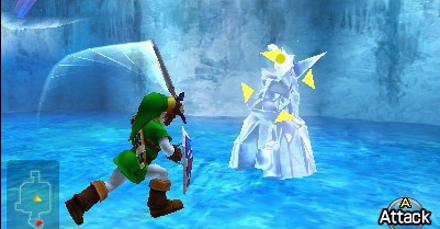
There's colour at every turn!
Hardcore fans will be pleased to hear that the Master Quest (which, again, originally came on the same bonus disk as the standard OoT game in special editions of Wind Waker) becomes available once the original version is complete. For those that don’t know, the Master Quest is something of a remix, with items and puzzles rearranged or presented differently to add an extra level of challenge to those interested. It certainly makes the game worth playing again.
Okay, there are some downsides amongst all of this gratuitous positivity. With the game being otherwise virtually untouched, there are times the camera will let you down in the midst of combat, especially when it comes to locking-on to a target. It doesn’t happen all too often, but when it does, it can get a tad frustrating. Yes, also, it’s worth mentioning that Navi is still here. She’s often regarded as the ‘Clippy: The Microsoft Office Assistant’ of the Zelda series, but to be honest, she never annoyed me all that much to begin with, so I didn’t really notice her this time around either. Just know that if she was something of a bugbear for you before, then she’s practically unchanged.
However, these are two extremely minor gripes and examples of me clutching at straws for something more balanced to say about the game. There are no real deal-breakers to be found here; Ocarina of Time is every bit as entertaining to play through now as it was originally.
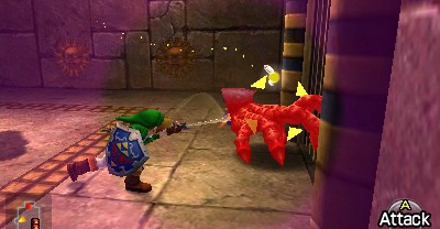
Nope, it's not Thing from the Addam's Family!
Ganondorf getting all up in yer face!
Let me just say this immediately: Ocarina of Time 3D is a beautiful game. Gorgeous in fact. It would have been so easy (and probably would have been enough) for Nintendo to wheel out a straight port of the N64 game with a 3D effect shoehorned over the top, but they made sure time was taken to bring the game up to date accordingly.
While it stops short of being completely rebuilt from the ground up (and let’s face it, we wouldn’t want that), it now looks like a game that’s just about worthy of being released this generation, even if only on handhelds. The brightness and the vibrant colours are probably the biggest differences to witness, while the newly polished, higher-res textures in some places make a wealth of difference to a game that, in its original state, could have only be classed as ‘charming’ by today’s standards.
Don’t get me wrong, it’s still every bit as charming. It still has that excellent NPC and environment design, it still oozes character and variety in every direction you face; it just looks a megaton better with it.
Then of course you have the 3D. Thankfully, it’s spectacularly utilised and up there with the best of games to show off your 3DS. I have to say, though, at times I did find it distracting, often turning on the 3D effect just for cut-scenes or after entering new areas, and then turning it off once gameplay had resumed. That may, however, just be down to my personal preference.
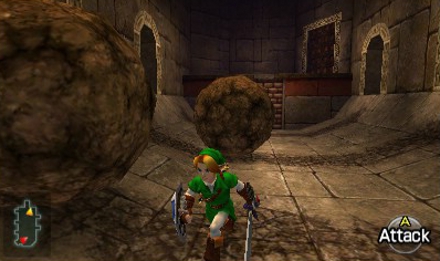
Indiana Link and the Dungeon of Doom!
Hey! Listen!
One area that hasn’t really received much of a brushing up is the audio, and that in itself is no bad thing. The soundtrack, produced and composed by Zelda stalwart Koji Kondo, is untouched here, and thankfully so. It’s not just nostalgia on my part when I say that it’s an amazing score, really, but it goes further than just having powerful pieces of music accompanying the action; it’s interactively integral to the game design.
That sentiment goes beyond the serene tunes for the titular ocarina that you’ll learn along the way, beyond the usual Zelda themes and even beyond the fact that each area has it’s own unique background that characterises it and brings it to life. The game excels in providing subtle audible recognition to keep you abreast of all that is going on, from the iconic noises when you trigger a door unlock or uncover a chest, to the hurried and ominous sound that occurs when you approach something that will cause you harm. It was ridiculously effective back then, and it’s just as effective now.
Enough with the gushing already!
Yes, you get it, I love this game. To be honest, I’ve waited a long time to be able to gush about Ocarina of Time, and I’ve finally been able to get that wish. I was apprehensive, of course, which is unsurprising when you consider the height of the pedestal I put the game on. However, it pleases me to say that thirteen years later and in nearly every way conceivable, the game still holds up today; such is the quality. Fans are going to love playing this updated version, rekindling their love of one of gaming’s great experiences, and I even envy the newcomers a little, getting to come into it with fresh eyes. Ocarina of Time is a magical game that’s full of wonder, and everyone should experience it at least once. For me? I think that annual playthrough might just be back on…
Platforms: 3DS | Tagged 3ds, Epona, Legend Of Zelda, Link, Nintendo, Ocarina of Time, Ocarina of Time 3DS, The Legend of Zelda, Zelda



